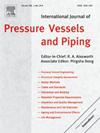Clarifying creep-susceptible zone in 9Cr steel weldments via interrupted testing
IF 3
2区 工程技术
Q2 ENGINEERING, MECHANICAL
International Journal of Pressure Vessels and Piping
Pub Date : 2025-02-20
DOI:10.1016/j.ijpvp.2025.105480
引用次数: 0
Abstract
9Cr steel welded joints are prone to Type IV premature failure during high-temperature service. Understanding the creep cracking mechanism and elucidating the microstructural evolution within the creep-susceptible zone constitute critical countermeasures preventing Type IV creep cracking. However, the exact location of the creep-susceptible zone remains ambiguous. Our findings reveal a notable migration of the soft zone in actual weldments during the secondary creep stage. Ensuing microstructural analysis further corroborates that microstructures within the creep-susceptible zone consist of tempered martensites with small prior austenite grain sizes and a high proportion of fine-grain ferrites (80.8 %). Fine-grained ferrites degrade rapidly during creep, accompanied by a swift decrease in dislocation density, leading to a significant reduction in hardness. Compared to tempered martensites, ferrite grain boundaries are more susceptible to creep cavity formation and coalescence, ultimately resulting in creep cracking along grain boundaries. These findings may offer valuable insights into the mechanisms of Type IV creep cracking and will facilitate tackling challenges pertinent to circumventing this failure mode.

通过中断试验澄清9Cr钢焊接件的蠕变敏感区
9Cr钢焊接接头在高温使用过程中容易发生IV型过早失效。了解蠕变开裂机理,阐明蠕变敏感区内的微观组织演变,是防止ⅳ型蠕变开裂的关键对策。然而,蠕变易感区的确切位置仍然不明确。我们的研究结果表明,在二次蠕变阶段,实际焊接件中的软区有明显的迁移。随后的显微组织分析进一步证实,蠕变敏感区内的显微组织由回火马氏体组成,具有较小的奥氏体晶粒尺寸和高比例的细晶铁素体(80.8%)。细晶铁素体在蠕变过程中迅速降解,伴随着位错密度的迅速降低,导致硬度显著降低。与回火马氏体相比,铁素体晶界更容易发生蠕变空洞形成和聚并,最终导致沿晶界蠕变开裂。这些发现可能为IV型蠕变开裂机制提供有价值的见解,并将有助于解决与规避这种破坏模式相关的挑战。
本文章由计算机程序翻译,如有差异,请以英文原文为准。
求助全文
约1分钟内获得全文
求助全文
来源期刊
CiteScore
5.30
自引率
13.30%
发文量
208
审稿时长
17 months
期刊介绍:
Pressure vessel engineering technology is of importance in many branches of industry. This journal publishes the latest research results and related information on all its associated aspects, with particular emphasis on the structural integrity assessment, maintenance and life extension of pressurised process engineering plants.
The anticipated coverage of the International Journal of Pressure Vessels and Piping ranges from simple mass-produced pressure vessels to large custom-built vessels and tanks. Pressure vessels technology is a developing field, and contributions on the following topics will therefore be welcome:
• Pressure vessel engineering
• Structural integrity assessment
• Design methods
• Codes and standards
• Fabrication and welding
• Materials properties requirements
• Inspection and quality management
• Maintenance and life extension
• Ageing and environmental effects
• Life management
Of particular importance are papers covering aspects of significant practical application which could lead to major improvements in economy, reliability and useful life. While most accepted papers represent the results of original applied research, critical reviews of topical interest by world-leading experts will also appear from time to time.
International Journal of Pressure Vessels and Piping is indispensable reading for engineering professionals involved in the energy, petrochemicals, process plant, transport, aerospace and related industries; for manufacturers of pressure vessels and ancillary equipment; and for academics pursuing research in these areas.

 求助内容:
求助内容: 应助结果提醒方式:
应助结果提醒方式:


